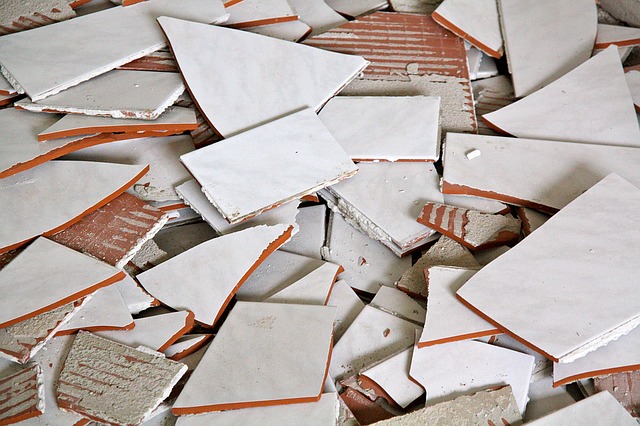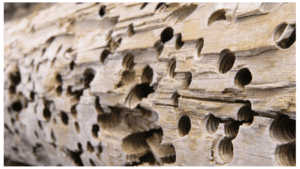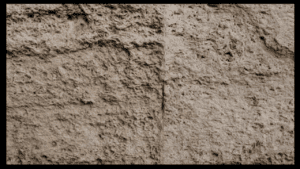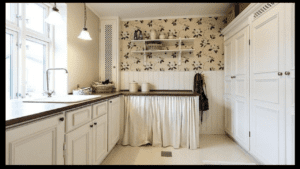Signs of termites in the ceilings are a bit difficult to find at the early stage because termites keep themselves hidden.
But if you keep on inspecting your home repairs from time to time, then you may be able to notice the termite infestation at an early stage.
Just as termites can infest walls, furniture, or even your clothes. In the same way, the ceiling can also be infested by termites due to many reasons. And believe me, it is very expensive to deal with such small bugs.
In this article, I will tell you the signs of termites in the ceiling. And how you can get rid of them or kill them by applying simple DIY. This will help you to get results like a pro without breaking your bank.
Signs of Termites in the Ceiling:
Until we know the signs of termites, we cannot get rid of them. The following signs indicate that you have a termite infestation on your roof ceiling.
Tiny Holes in Ceiling:
If you see tiny holes on the ceiling of your roof that are filled with sawdust, then it means you have dry wood termites in the ceilings.
These holes appear when some adult termites leave their colony and come out from their nest. Because the old nest doesn’t have enough space or food. Once they come out they look to build more colonies. And this is the riskiest time when termites can attack anything.
These pinholes are later filled with their own feces as they don’t want outside air to dry the moisture inside their colony.
Mud Tubes or Mud Tunnels on Ceiling:
If you see mud tubes on the ceiling of your roof, then understand that it is an infestation of subterranean termites.
Subterranean termites use this type of mud tubes to carry food from the food source to their colony. And to retain moisture as they can not survive without moisture.
Cracks in the Ceiling:
Cracks in the ceiling are strong evidence of termite infestation. They appear when the wooden structure of the ceiling is destroyed by termites. It starts feeding on the timber which causes cracks on the walls.
If you take care of the ceiling from time to time, then you can detect and treat such cracks at an early stage.
Mounds of Frass on Ceiling:
Whenever you see mounds of sawdust on your attic or on your ceiling, then understand that it is due to Drywood termite infestation.
Since the Drywood termites consume dry wood, their excreta when collected in one place looks exactly like sawdust.
Discarded Wings on Floor:
Whenever termites come out of their nest to breed, males choose their females and females choose males. It is during this process that adult termites discard their wings and do this to attract each other.
Where there is termites infestation, you can easily find out these discarded wings on the floor of your house.
Stains or Discoloration of Ceilings:
When your ceiling gets damp due to rain or leakage, then the ceiling gets stained and causes discoloring.
And so is the case with termites. When a termite invades the ceiling of your home, it keeps its colony completely moist with its excrement so that it can survive and as a result of the moisture created by them, you see spots or discoloring in the ceiling.
Sagging in The Ceilings:
The sagging of ceilings or walls is evidence that termites have entered into the ceiling structures. as soon as it enters, it starts spoiling the structure by creating moisture in it, or they feed on wood inside out due to which many times, you see sagging in the ceilings or walls. Sometimes it also causes the collapse of ceilings.
Broken or Loose Roof Tiles:
When termites enter the ceiling structure, it creates moisture from its excrement there and also eats wooden shingles or wooden in subroof. This causes roof tiles to get loose or break. If your roof tiles are starting to come out, then termites could also be one of the reasons.
These are all solid proofs to show that the ceiling of your roof has been attacked by termites. Now I will tell you some natural methods to get rid of them that too in a professional way at a low cost.
How to Prevent Termites from Entering the Ceiling or Coming Back?
“Prevention Is Better Than Cure” there is an old saying that fits perfectly with termites. Because once termites infest your ceilings, they are not easy to catch in the beginning, and by the time you notice the infestation, it is too late.
I will tell you how you can protect your ceilings in advance and how you can also recognize an early infestation. So that you can get rid of the termites of the ceiling.
Do not allow moisture to accumulate on the ceiling:
A moist place is a haven for termites. In such a situation, if the moist has accumulated due to any leakage on your ceiling, then remove it immediately. Because in such a situation, there is a huge risk of termite’s attack on your roof ceilings.
Remove old newspaper, cardboards, or trash:
Old cardboard boxes, newspapers, or old wallpaper on walls attract termites. In such a situation, if it infects the old waste, then it does not take much time to reach the ceilings. So you should not store the waste in your house at all, especially when it is humid weather.
Do not keep old furniture or wooden things on your roof:
Especially during the rainy season, you should remove all the items lying on your roof because if furniture or old trash gets wet then it attracts termites and thus termites can infest your ceilings.
Repair Broken Tiles:

Broken roof tiles are the easiest way for termites to get into the structure of your ceiling. Once termites attack the structure of your ceiling, they spread very quickly, so you should repair your broken roof tiles as soon as possible.
Fix The Leakage:
You should inspect your bathrooms and toilets from time to time and get any water leakage fixed immediately as it happens many times that due to the leakage, moisture comes on the walls and then termites start growing in the moisture.
Seal The Cracks or Holes:
Ceiling or roof cracks act as an entrance for termites to enter the structure of your ceiling. Therefore, you should immediately seal any cracks or holes on walls, floor, or roof ceilings.
Use Boracare Natural Borate for Preventing Termites:
Whenever you get your new construction painted or repainted, be sure to use borate. This is a very popular method that people use to protect their homes from termites. You have to spray borate on wood before the painting or priming. Once it is dried you can paint. It works very effectively to prevent termites permanently.
Early Signs of Termites on Ceiling:
Getting rid of termites is a little easier if you spot the signs early. Because then they are few in number. But when they spread, it becomes a bit difficult to control them.
The appearance of discarded wings of a termite on your floor is an early sign that it is about to spread. Second, if you see pinholes on your ceiling, you can understand that termites have attacked the ceiling. Loosening or cracking of your roof tiles is also an early sign of infestation.
Conclusion:
Before treating termites on a roof ceiling, you need to recognize the signs of termites in the ceiling. Once you get these signs, then you can start your treatment.
I have also shared some ideas on how you can prevent termites from coming back to the ceilings. If the infestation has spread much then you must contact a professional.
Investing in professional pest removal services ensures that the termites do not return and cause more havoc in your home. Pest Control specialists will apply the pesticide around the perimeter of your home, ultimately killing the termites upon contact.
Not only will this do the job quickly and efficiently, but it will also save you lots of time (and money). This will also ensure that the termites do not return, giving you peace of mind! For more information on pest control services, take a look at https://www.thebustersgroup.co.uk/.





